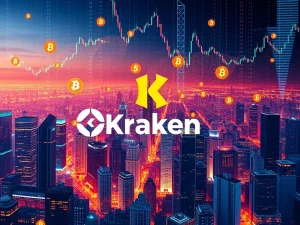Bitcoin Price Japan: Unpacking the Astonishing Rally Fuelled by Bond Turmoil

BitcoinWorld
Bitcoin Price Japan: Unpacking the Astonishing Rally Fuelled by Bond Turmoil
The cryptocurrency world has been buzzing about Bitcoin’s recent surge to new all-time highs. While factors like the halving event and U.S. spot ETF inflows are often cited, analysts are pointing to a less obvious, yet significant, driver: instability in Japan’s bond market. Understanding the Bitcoin price Japan connection reveals fascinating dynamics at play in the global financial system.
Is Japan’s Bond Market Shaking Up Bitcoin?
Yes, according to some prominent market watchers. The core idea is that rising yields in Japan’s government bond market signal potential stress and increased sovereign credit risk for one of the world’s largest economies. When the cost for a government to borrow money (the yield on its bonds) goes up significantly, it can make investors nervous about the stability of that nation’s finances.
Here’s a breakdown of the situation:
Japan has maintained ultra-low interest rates and bond yields for decades as part of its economic policy.
Recently, yields on longer-term Japanese government bonds (JGBs), particularly the 30-year yield, have been climbing, reaching levels not seen in years or even decades.
This rise suggests market participants are demanding higher returns to hold Japanese debt, indicating concerns about future inflation or the government’s ability to manage its considerable debt load.
This volatility in the Japan bond market is reportedly causing institutional investors to look for alternative assets that are not tied to traditional government debt or fiat currencies.
Why is Japan Bond Volatility Driving Bitcoin Interest?
The link stems from the perception of Bitcoin as a potential hedge against traditional financial system risks. When sovereign debt markets in major economies show signs of stress, investors, especially large institutions, begin searching for assets that are uncorrelated or even negatively correlated with these risks.
Bitwise Asset Management’s Senior Macro Analyst, André Dragosch, highlighted this trend, noting the record high hit by the 30-year Japanese government bond yield. His analysis suggests this move prompted institutional investors to consider Bitcoin as a hedge against potential sovereign default risk. Unlike government bonds or fiat currency tied to a specific nation’s economy, Bitcoin is decentralized and operates outside the direct control of any single government or central bank.
Think of it this way:
If you are a large fund holding significant amounts of Japanese government bonds, and you see their value potentially eroding due to rising yields or concerns about Japan’s fiscal health, you might seek an asset that behaves differently. Bitcoin, with its finite supply and global, decentralized network, presents itself as one such alternative.
Is Bitcoin a True Safe Haven Asset?
The debate around whether Bitcoin safe haven status is legitimate continues. Traditionally, assets like gold, certain currencies (like the Swiss Franc), or even specific government bonds (in times of global turmoil) have been considered safe havens – places investors flock to during periods of economic or geopolitical uncertainty.
Arguments for Bitcoin as a safe haven:
Decentralization: Not controlled by any government or central bank, immune to national monetary policy shifts or political instability (unlike fiat currencies or government bonds).
Scarcity: Fixed supply cap (21 million coins) provides a perceived store of value similar to precious metals.
Global Accessibility: Can be accessed and transferred anywhere in the world, bypassing traditional banking systems.
Arguments against Bitcoin as a safe haven:
Volatility: Bitcoin’s price is known for dramatic swings, which contradicts the traditional definition of a stable safe haven asset.
Lack of Long-Term Track Record: Relatively young asset class compared to gold or reserve currencies.
Regulatory Uncertainty: Its decentralized nature also means it operates in a complex and evolving regulatory landscape across different countries.
However, the current narrative linking it to Japan’s bond market suggests that, for some sophisticated investors, Bitcoin is increasingly viewed through this ‘digital gold’ or uncorrelated asset lens, particularly when specific sovereign risks emerge in major economies.
The Role of Institutional Bitcoin Adoption
The thesis put forward by analysts like Dragosch heavily relies on Institutional Bitcoin adoption. It’s not just retail traders reacting to news; it’s the movement of significant capital by large funds, corporations, and asset managers that can truly impact market prices.
Several factors point to growing institutional interest:
Spot ETF Approvals: The launch of U.S. spot Bitcoin ETFs has provided a regulated and accessible avenue for institutions to gain exposure to Bitcoin without directly holding the asset.
Corporate Treasury Strategies: Some corporations have added Bitcoin to their balance sheets as a hedge against inflation or currency devaluation.
Fund Allocations: Macro hedge funds and other investment vehicles are increasingly including Bitcoin in their portfolios as part of diversification strategies.
The idea is that the scale of capital managed by these institutions means even a small allocation to Bitcoin as a hedge against sovereign risk, especially from a market as large as Japan’s, can create substantial buying pressure.
What Does This Mean for Bitcoin Market Analysis?
This connection between the Bitcoin market analysis and traditional macroeconomics, specifically sovereign debt markets, adds a new layer of complexity. It suggests that global financial stability (or lack thereof) in major economies can become a significant factor influencing Bitcoin’s price movements, alongside crypto-specific events like the halving or ETF flows.
Analyst predictions, such as Dragosch’s projection of Bitcoin potentially reaching $200,000, are often contingent on the continuation of these macro trends and sustained institutional buying. If Japan’s bond market volatility persists, or if similar sovereign risk concerns arise in other major economies, the demand for perceived uncorrelated assets like Bitcoin could continue to grow.
Actionable Insights for Investors:
Stay Informed: Pay attention not just to crypto news but also to major global macroeconomic developments, particularly sovereign debt markets in large economies.
Understand the Narrative: Recognize that part of Bitcoin’s value proposition for institutions is its potential as a hedge against traditional financial risks.
Consider Diversification: While Bitcoin is volatile, its potential uncorrelated nature might make it a component of a diversified portfolio for some investors.
Evaluate Predictions Carefully: Price targets like $200,000 are based on specific conditions and trends continuing; they are not guarantees.
Potential Challenges:
Correlation Risk: Bitcoin could still correlate with traditional markets during extreme stress events.
Regulatory Headwinds: Increased institutional adoption could also bring more regulatory scrutiny.
Market Sentiment Shifts: The narrative could change rapidly, impacting demand.
Compelling Summary
The recent surge in Bitcoin’s price appears to be influenced not just by crypto-native factors but also by macro-financial dynamics in distant markets like Japan’s. Volatility and rising yields in the Japan bond market are prompting some institutional investors to view Bitcoin as a potential Bitcoin safe haven or hedge against sovereign risk. This growing trend of Institutional Bitcoin adoption, driven partly by global financial instability, is a significant element in the current Bitcoin market analysis and future price predictions, including projections like $200,000, provided this institutional interest and the underlying macro drivers persist. The Bitcoin price Japan connection highlights the increasing integration of the crypto asset into the broader global financial landscape.
To learn more about the latest Bitcoin market analysis trends, explore our articles on key developments shaping Bitcoin price action.
This post Bitcoin Price Japan: Unpacking the Astonishing Rally Fuelled by Bond Turmoil first appeared on BitcoinWorld and is written by Editorial Team










